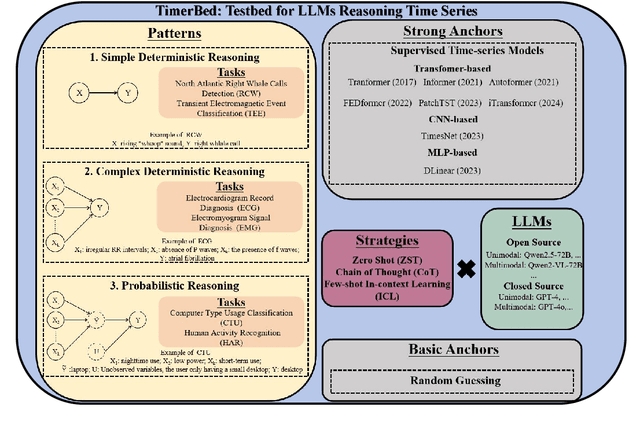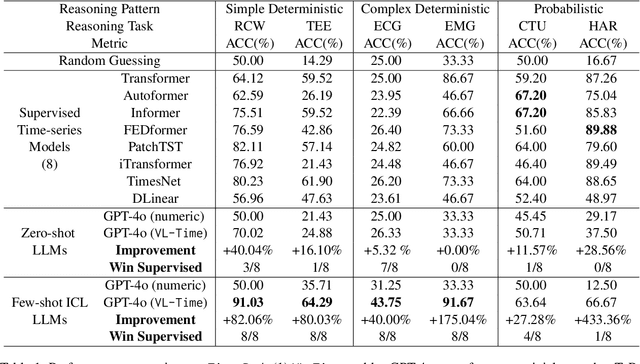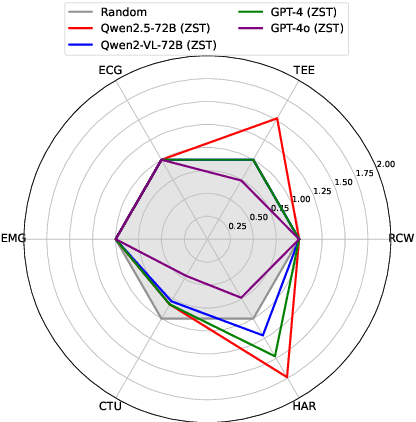Chenghao Liu
Beijing Institute of Technology
The Power of Architecture: Deep Dive into Transformer Architectures for Long-Term Time Series Forecasting
Jul 17, 2025Abstract:Transformer-based models have recently become dominant in Long-term Time Series Forecasting (LTSF), yet the variations in their architecture, such as encoder-only, encoder-decoder, and decoder-only designs, raise a crucial question: What Transformer architecture works best for LTSF tasks? However, existing models are often tightly coupled with various time-series-specific designs, making it difficult to isolate the impact of the architecture itself. To address this, we propose a novel taxonomy that disentangles these designs, enabling clearer and more unified comparisons of Transformer architectures. Our taxonomy considers key aspects such as attention mechanisms, forecasting aggregations, forecasting paradigms, and normalization layers. Through extensive experiments, we uncover several key insights: bi-directional attention with joint-attention is most effective; more complete forecasting aggregation improves performance; and the direct-mapping paradigm outperforms autoregressive approaches. Furthermore, our combined model, utilizing optimal architectural choices, consistently outperforms several existing models, reinforcing the validity of our conclusions. We hope these findings offer valuable guidance for future research on Transformer architectural designs in LTSF. Our code is available at https://github.com/HALF111/TSF_architecture.
MolCLIP: A Molecular-Auxiliary CLIP Framework for Identifying Drug Mechanism of Action Based on Time-Lapsed Mitochondrial Images
Jul 10, 2025Abstract:Drug Mechanism of Action (MoA) mainly investigates how drug molecules interact with cells, which is crucial for drug discovery and clinical application. Recently, deep learning models have been used to recognize MoA by relying on high-content and fluorescence images of cells exposed to various drugs. However, these methods focus on spatial characteristics while overlooking the temporal dynamics of live cells. Time-lapse imaging is more suitable for observing the cell response to drugs. Additionally, drug molecules can trigger cellular dynamic variations related to specific MoA. This indicates that the drug molecule modality may complement the image counterpart. This paper proposes MolCLIP, the first visual language model to combine microscopic cell video- and molecule-modalities. MolCLIP designs a molecule-auxiliary CLIP framework to guide video features in learning the distribution of the molecular latent space. Furthermore, we integrate a metric learning strategy with MolCLIP to optimize the aggregation of video features. Experimental results on the MitoDataset demonstrate that MolCLIP achieves improvements of 51.2% and 20.5% in mAP for drug identification and MoA recognition, respectively.
Empowering Time Series Analysis with Synthetic Data: A Survey and Outlook in the Era of Foundation Models
Mar 14, 2025Abstract:Time series analysis is crucial for understanding dynamics of complex systems. Recent advances in foundation models have led to task-agnostic Time Series Foundation Models (TSFMs) and Large Language Model-based Time Series Models (TSLLMs), enabling generalized learning and integrating contextual information. However, their success depends on large, diverse, and high-quality datasets, which are challenging to build due to regulatory, diversity, quality, and quantity constraints. Synthetic data emerge as a viable solution, addressing these challenges by offering scalable, unbiased, and high-quality alternatives. This survey provides a comprehensive review of synthetic data for TSFMs and TSLLMs, analyzing data generation strategies, their role in model pretraining, fine-tuning, and evaluation, and identifying future research directions.
Position: Empowering Time Series Reasoning with Multimodal LLMs
Feb 03, 2025



Abstract:Understanding time series data is crucial for multiple real-world applications. While large language models (LLMs) show promise in time series tasks, current approaches often rely on numerical data alone, overlooking the multimodal nature of time-dependent information, such as textual descriptions, visual data, and audio signals. Moreover, these methods underutilize LLMs' reasoning capabilities, limiting the analysis to surface-level interpretations instead of deeper temporal and multimodal reasoning. In this position paper, we argue that multimodal LLMs (MLLMs) can enable more powerful and flexible reasoning for time series analysis, enhancing decision-making and real-world applications. We call on researchers and practitioners to leverage this potential by developing strategies that prioritize trust, interpretability, and robust reasoning in MLLMs. Lastly, we highlight key research directions, including novel reasoning paradigms, architectural innovations, and domain-specific applications, to advance time series reasoning with MLLMs.
GDformer: Going Beyond Subsequence Isolation for Multivariate Time Series Anomaly Detection
Jan 30, 2025



Abstract:Unsupervised anomaly detection of multivariate time series is a challenging task, given the requirements of deriving a compact detection criterion without accessing the anomaly points. The existing methods are mainly based on reconstruction error or association divergence, which are both confined to isolated subsequences with limited horizons, hardly promising unified series-level criterion. In this paper, we propose the Global Dictionary-enhanced Transformer (GDformer) with a renovated dictionary-based cross attention mechanism to cultivate the global representations shared by all normal points in the entire series. Accordingly, the cross-attention maps reflect the correlation weights between the point and global representations, which naturally leads to the representation-wise similarity-based detection criterion. To foster more compact detection boundary, prototypes are introduced to capture the distribution of normal point-global correlation weights. GDformer consistently achieves state-of-the-art unsupervised anomaly detection performance on five real-world benchmark datasets. Further experiments validate the global dictionary has great transferability among various datasets. The code is available at https://github.com/yuppielqx/GDformer.
Incremental Label Distribution Learning with Scalable Graph Convolutional Networks
Nov 20, 2024



Abstract:Label Distribution Learning (LDL) is an effective approach for handling label ambiguity, as it can analyze all labels at once and indicate the extent to which each label describes a given sample. Most existing LDL methods consider the number of labels to be static. However, in various LDL-specific contexts (e.g., disease diagnosis), the label count grows over time (such as the discovery of new diseases), a factor that existing methods overlook. Learning samples with new labels directly means learning all labels at once, thus wasting more time on the old labels and even risking overfitting the old labels. At the same time, learning new labels by the LDL model means reconstructing the inter-label relationships. How to make use of constructed relationships is also a crucial challenge. To tackle these challenges, we introduce Incremental Label Distribution Learning (ILDL), analyze its key issues regarding training samples and inter-label relationships, and propose Scalable Graph Label Distribution Learning (SGLDL) as a practical framework for implementing ILDL. Specifically, in SGLDL, we develop a New-label-aware Gradient Compensation Loss to speed up the learning of new labels and represent inter-label relationships as a graph to reduce the time required to reconstruct inter-label relationships. Experimental results on the classical LDL dataset show the clear advantages of unique algorithms and illustrate the importance of a dedicated design for the ILDL problem.
A Picture is Worth A Thousand Numbers: Enabling LLMs Reason about Time Series via Visualization
Nov 09, 2024



Abstract:Large language models (LLMs), with demonstrated reasoning abilities across multiple domains, are largely underexplored for time-series reasoning (TsR), which is ubiquitous in the real world. In this work, we propose TimerBed, the first comprehensive testbed for evaluating LLMs' TsR performance. Specifically, TimerBed includes stratified reasoning patterns with real-world tasks, comprehensive combinations of LLMs and reasoning strategies, and various supervised models as comparison anchors. We perform extensive experiments with TimerBed, test multiple current beliefs, and verify the initial failures of LLMs in TsR, evidenced by the ineffectiveness of zero shot (ZST) and performance degradation of few shot in-context learning (ICL). Further, we identify one possible root cause: the numerical modeling of data. To address this, we propose a prompt-based solution VL-Time, using visualization-modeled data and language-guided reasoning. Experimental results demonstrate that Vl-Time enables multimodal LLMs to be non-trivial ZST and powerful ICL reasoners for time series, achieving about 140% average performance improvement and 99% average token costs reduction.
XForecast: Evaluating Natural Language Explanations for Time Series Forecasting
Oct 21, 2024Abstract:Time series forecasting aids decision-making, especially for stakeholders who rely on accurate predictions, making it very important to understand and explain these models to ensure informed decisions. Traditional explainable AI (XAI) methods, which underline feature or temporal importance, often require expert knowledge. In contrast, natural language explanations (NLEs) are more accessible to laypeople. However, evaluating forecast NLEs is difficult due to the complex causal relationships in time series data. To address this, we introduce two new performance metrics based on simulatability, assessing how well a human surrogate can predict model forecasts using the explanations. Experiments show these metrics differentiate good from poor explanations and align with human judgments. Utilizing these metrics, we further evaluate the ability of state-of-the-art large language models (LLMs) to generate explanations for time series data, finding that numerical reasoning, rather than model size, is the main factor influencing explanation quality.
Moirai-MoE: Empowering Time Series Foundation Models with Sparse Mixture of Experts
Oct 14, 2024



Abstract:Time series foundation models have demonstrated impressive performance as zero-shot forecasters. However, achieving effectively unified training on time series remains an open challenge. Existing approaches introduce some level of model specialization to account for the highly heterogeneous nature of time series data. For instance, Moirai pursues unified training by employing multiple input/output projection layers, each tailored to handle time series at a specific frequency. Similarly, TimesFM maintains a frequency embedding dictionary for this purpose. We identify two major drawbacks to this human-imposed frequency-level model specialization: (1) Frequency is not a reliable indicator of the underlying patterns in time series. For example, time series with different frequencies can display similar patterns, while those with the same frequency may exhibit varied patterns. (2) Non-stationarity is an inherent property of real-world time series, leading to varied distributions even within a short context window of a single time series. Frequency-level specialization is too coarse-grained to capture this level of diversity. To address these limitations, this paper introduces Moirai-MoE, using a single input/output projection layer while delegating the modeling of diverse time series patterns to the sparse mixture of experts (MoE) within Transformers. With these designs, Moirai-MoE reduces reliance on human-defined heuristics and enables automatic token-level specialization. Extensive experiments on 39 datasets demonstrate the superiority of Moirai-MoE over existing foundation models in both in-distribution and zero-shot scenarios. Furthermore, this study conducts comprehensive model analyses to explore the inner workings of time series MoE foundation models and provides valuable insights for future research.
GIFT-Eval: A Benchmark For General Time Series Forecasting Model Evaluation
Oct 14, 2024



Abstract:Time series foundation models excel in zero-shot forecasting, handling diverse tasks without explicit training. However, the advancement of these models has been hindered by the lack of comprehensive benchmarks. To address this gap, we introduce the General Time Series Forecasting Model Evaluation, GIFT-Eval, a pioneering benchmark aimed at promoting evaluation across diverse datasets. GIFT-Eval encompasses 28 datasets over 144,000 time series and 177 million data points, spanning seven domains, 10 frequencies, multivariate inputs, and prediction lengths ranging from short to long-term forecasts. To facilitate the effective pretraining and evaluation of foundation models, we also provide a non-leaking pretraining dataset containing approximately 230 billion data points. Additionally, we provide a comprehensive analysis of 17 baselines, which includes statistical models, deep learning models, and foundation models. We discuss each model in the context of various benchmark characteristics and offer a qualitative analysis that spans both deep learning and foundation models. We believe the insights from this analysis, along with access to this new standard zero-shot time series forecasting benchmark, will guide future developments in time series foundation models. The codebase, datasets, and a leaderboard showing all the results in detail will be available soon.
 Add to Chrome
Add to Chrome Add to Firefox
Add to Firefox Add to Edge
Add to Edge